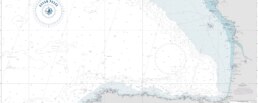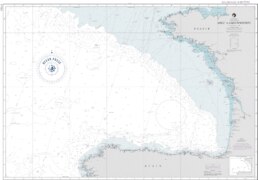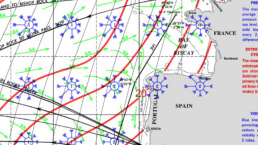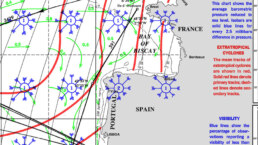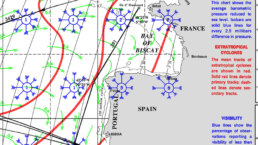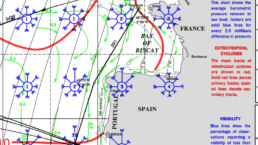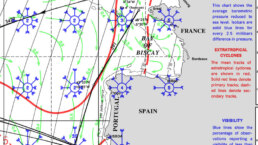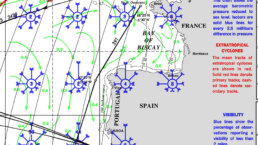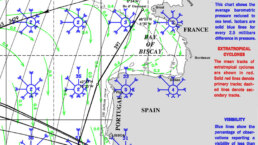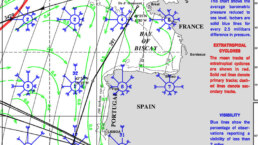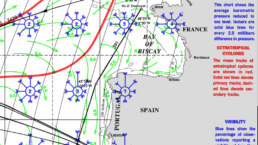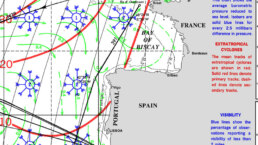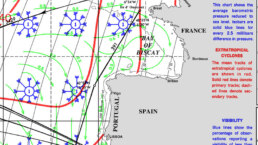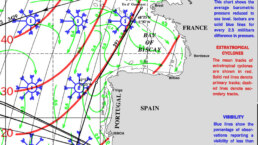Crossing, Sailing or Cruising the Bay of Biscay with the Ocean Posse
The Bay of Biscay – A Notorious Stretch of Water
The Bay of Biscay, stretching between the rugged northwest coast of Spain and the west coast of France, has a well-earned reputation for being one of the more challenging bodies of water in Western Europe. Long Atlantic swells, unpredictable winds, and sudden weather shifts make this area a passage to be planned with respect and precision. For sailors making their way from the English Channel to Spain or Portugal—or further afield to the Mediterranean—understanding the best time to cross can make the difference between an exhilarating passage and a punishing ordeal.
Seasonal Overview – When to Go
Spring (March to May)
Spring is often a tempting time for cruisers eager to head south early, but the Bay of Biscay can still deliver winter-like conditions well into April. Low-pressure systems sweeping across the North Atlantic remain frequent, bringing strong westerlies and occasional gales. Sea temperatures are cold, and squally showers are common. However, by late May, the frequency of severe storms decreases, and high-pressure systems begin to dominate, offering calmer windows.
• Pros: Longer daylight hours by May; slightly less yacht traffic; improving weather late in the season.
• Cons: Unpredictable weather systems; residual winter storms; colder sea temperatures.
• Best time in spring: Late May when the Azores High begins to stabilize weather patterns.
Summer (June to August)
Summer is the prime season for crossing the Bay of Biscay. The influence of the Azores High, a semi-permanent high-pressure system, is strongest at this time, generally bringing settled weather, lighter winds, and calmer seas. The prevailing winds tend to be northerly or northwesterly, which favors yachts heading south to Spain and Portugal.
• Pros: Most stable weather, longest daylight hours, calmer sea states, and more predictable conditions.
• Cons: Occasionally light or variable winds may require motoring; fog can appear, especially near the French coast; increased yacht and commercial traffic in busy ports.
• Best time in summer: Late June to mid-August for the highest likelihood of settled conditions.
Autumn (September to November)
Early autumn can still provide good sailing conditions, particularly in September when sea temperatures remain warm and the Azores High may still be in place. However, by late September, the risk of Atlantic depressions increases. October and November mark the transition back to harsher weather, with frequent gales and rough seas.
• Pros: September often offers mild temperatures and relatively settled weather; less busy marinas as summer crowds disperse.
• Cons: Increasing risk of strong lows from mid-September onward; shorter daylight hours; higher likelihood of storms as winter approaches.
• Best time in autumn: First two weeks of September only.
Winter (December to February)
Crossing the Bay of Biscay in winter is generally discouraged for cruising yachts unless absolutely necessary. The Atlantic storm track is at its most active, with frequent gales, strong westerlies, and heavy swells. Even commercial shipping often diverts or delays during intense winter storms.
• Pros: Virtually none for pleasure yachts; only for seasoned offshore sailors with time-critical schedules.
• Cons: Severe weather, long periods of rough seas, short daylight hours, and colder water increasing the risk of hypothermia in emergencies.
Best Practices for Timing Your Passage
- Wait for a Stable High-Pressure System
Look for a clear, established high with at least 3 to 4 days of stable northerly or northwesterly winds. Avoid departing ahead of approaching lows. - Monitor GRIB Files and Forecast Models
Use multiple weather sources such as Météo-France, PassageWeather, and Windy to track pressure systems at least a week ahead. - Choose a 3-4 Day Window
Most Biscay crossings take between 2 and 4 days for cruising yachts. Ensure your chosen weather window extends beyond your estimated passage time. - Depart Early in the Morning
Leaving with first light gives maximum daylight for the first day and allows you to clear coastal headlands before nightfall. - Avoid Lee Shores in Rising Winds
If southwesterlies are forecast, reconsider departure. The Spanish coast can quickly become a dangerous shore in deteriorating weather. - Consider a Night Arrival Plan
If delayed, ensure you are comfortable making landfall in the dark or have alternate ports identified.
Practical Tips for a Comfortable Crossing
• Crew Preparedness: Biscay’s long Atlantic swell can test stomachs. Prepare for seasickness prevention, even in calm conditions.
• Secure Below Decks: Stow gear properly; Biscay can still produce lumpy seas even in good weather.
• Watch Rotations: With long daylight hours in summer, plan watch schedules to maximize rest.
• Fuel and Engine Checks: Expect light winds in high-pressure systems, meaning motoring is common.
Summary – The Best Time to Cross
For most cruisers, late June through mid-August offers the best combination of settled weather, reliable high-pressure systems, and comfortable sea states. Late May and early September can also provide good windows but with slightly higher risks of variable weather. Avoid winter unless you are highly experienced and time-constrained.
By respecting seasonal weather patterns, choosing a stable forecast window, and preparing thoroughly, the Bay of Biscay can be a rewarding gateway—rather than a dreaded obstacle—on your voyage south.
Direct Route
Most crews punch straight south-southwest from a French port, making landfall on Spain’s rugged north coast – A Coruña is the usual target. Expect 2 to 3 nights of continuous sailing, depending on departure point and hull speed. Treat it like what it is – a short ocean leg, not just a coastal hop.
Intermediate Stops
If you’d rather ease into Biscay or need a weather window, you can stage the trip with stopovers. Belle Île works before the jump, or you can aim for Gijón or Viveiro once you’re across – both offer good shelter and solid facilities.
Distance & Reality Check
• Brest to A Coruña, direct: ~360 miles
• Or coastal Route with day hops ( waiting out weather windows )
For many crews, Biscay is the first real offshore test – expect fatigue, seasickness, and the uncomfortable truth that you’re a long way from help if something goes wrong. Prepare like it’s a mini ocean crossing: thorough maintenance beforehand, solid crew briefings, and a realistic plan.
Tactics & Tips
• Time your departure – hit the shelf in settled conditions if you can. A northwest breeze over a leftover southwest swell will build steep, nasty cross seas.
• Daylight crossing over the shelf helps – you’ll see the wave sets (and those wandering fishing boats) coming.
• Best hands on deck for this leg – alert, experienced watchkeepers make the difference.
• In heavy weather, stay west of 7° – crews report a cleaner sea state out there.
BAY OF BISCAY ROUTES
French Polynesia Long Stay Visa Procedure
French Polynesia Long Stay Visa Application:
It's a Process not Rocket Science
By Maurisa Descheemaeker on SV WHIRLWIND

The best place to start getting familiar with the procedure is on the French governments visa wizard landing page: https://france-visas.gouv.fr/en/visa-wizard On the visa-wizard page you enter in your nationality, your destination, and plans in said destination. In short you will find that with the exception of:
- Citizens of the European Union, Monaco and Andorra, for all territories.
- Citizens of the European Economic Area (EEA) and Switzerland, except French Polynesia, New Caledonia, Wallis-et-Futuna and the French Southern and Antarctic Lands (TAAF)
all citizens wishing to stay in French Polynesia for more than 90 days must apply for a long-stay visa BEFORE arriving in French Polynesia. Anywhere there is a French Embassy one may apply for a long-stay visa for French Polynesia. We were planning to set sail from Panama so we had our application appointment in Panama City and said as much on the application. As a US citizen with plans to cruise in French Polynesia for more than 90 days the wizard determined that I needed to apply for a long-stay visa and then directed me to the online application link. In this link you create an account with a username and password. You may then access, fill out, and submit your application. Once the application is submitted you can book an appointment to go in person to the embassy to present yourself, your application and all required supporting documents.
Honestly, with all the information from well intentioned cruisers on the internet about the process and all the changes over the years I felt mixed waves of uncertainty before I started the application. I quickly realized that .he path to the Long-stay visa is a process not rocket science. My waves of uncertainty were more of a mental block than an actual challenge because once I got started with the application I found the process very straightforward albeit a bit tedious. Furthermore, any time I had a question I wrote directly to the embassy in the country I was applying from. The response was very quick and very clear. Asking the embassy directly was very helpful because the rules were one way before COVID, another way during COVID, and another way still since COVID. The process and requirements have and may still be changing so the best source of information is the government agency directly.
That said, there were a few questions that felt like wild cards that actually were not because upon asking I was given black and white responses:
- There is a question of when to apply: Each embassy has different processing times so ask directly. Panama told me 4-6 weeks and they were. It is important to note that you cannot apply more than 90 day before your expected arrival date.
- There is a question of when you will arrive: Our best guess was provided. We arrived a month later and this was fine. You basically have the duration of your visa to arrive.
- There is a question of providing your passport for review: Different embassies have different requirement regarding passports. Some require looking at it and scanning it immediately, some hold it overnight or more. Ask ahead so you know what to expect. We provided a letter stating that we needed to hold on to ours and this was acceptable.
- There is a question of who is applying: I was applying for myself, my husband, and our two kids. This is very easily done in the online application by stating that I was 'travelling in a group' so I just added people to my one application instead of making four applications.
- There is a question of an address: I am a citizen of the United States and provided my address in the US. Regarding an address in French Polynesia I stated that I planned to be cruising. I would be living about my vessel everywhere I went. This was true and fine. I stated the Island groups I planned to visit.
- There is a question of health coverage: I asked the embassy exact what the minimum requirements were and found a plan that met or exceeded them.
- There is a question of socio-economic status: I asked the embassy exactly what this meant she replied that: Socio-economic status would be for example retired/employed/company owner etc, which you need to show proof of.
- There is a question of funds: I asked the embassy what the minimum requirement was. In January 2023, when we applied the requirement regarding the funds was that you had to prove that you had or have coming in an annual amount equal to 12 times the amount of the monthly minimum wage in France (currently 16,784.32€) per adult. This would certainly be something to ask specifically about as minimum wage changes. They ask that proof of the funds is by presenting the last 3 months of bank statements preceding your application appointment. These can show monthly income equal to monthly minimum wage or a balance holding the annual income stated above.
After I made my way through the online application successfully, I was then able to make an appointment to present everything in person at the embassy. The in person appointment is when we provided our passports, extra passport photos, printed and signed applications, all supporting documents, and the processing fee in cash. The supporting documents I provided included two separate letters in English and French (using Google Translate): one stating that I had no plans of seeking employment in French Polynesia (this does not exclude me from working remotely for a US company as revealed in the question of funds on the application) and one stating that I homeschool my children. I also provided a document from my school superintendent my kids status as enrolled homeschoolers, our marriage license and birth certificate copies for each of our kids.

In Panama, the French Embassy is located on a lovely point in Casco Viejo. After the Visa appointment we took the afternoon to enjoy Casco Viejo which was a lovely treat! Then we waited the 4-6 weeks to hear back via email that our visas were approved. We then made yet another appointment to return to the French Embassy with our passports to get our visas, and enjoy another afternoon in Casco Viejo.
Again, every French Embassy in each country may have slightly different protocols. Check with the Embassy directly to know exactly what they require so that your efforts to secure a long-stay visa in French Polynesia are smooth and easy.

